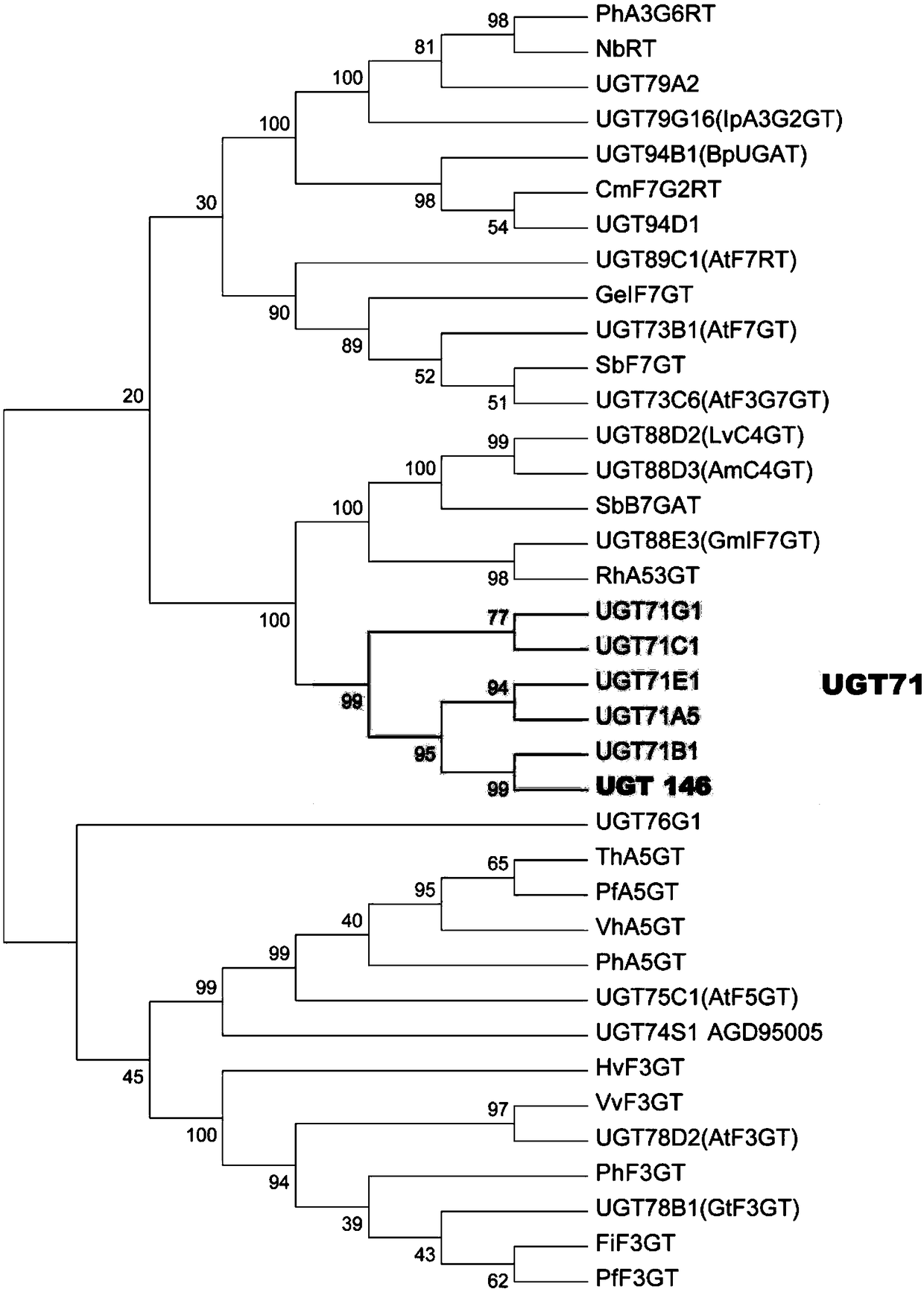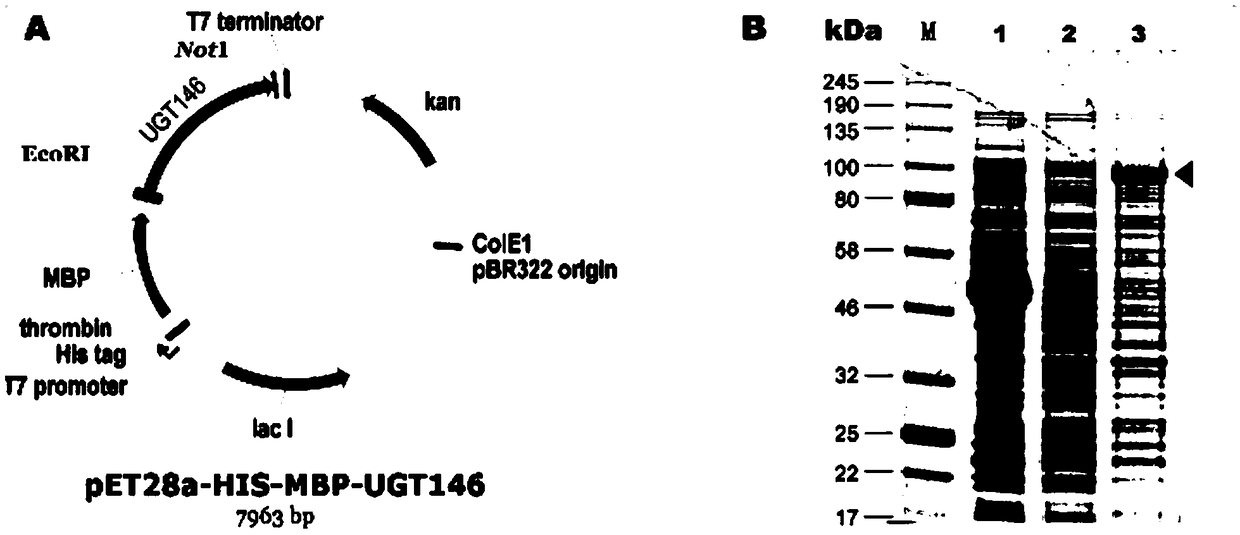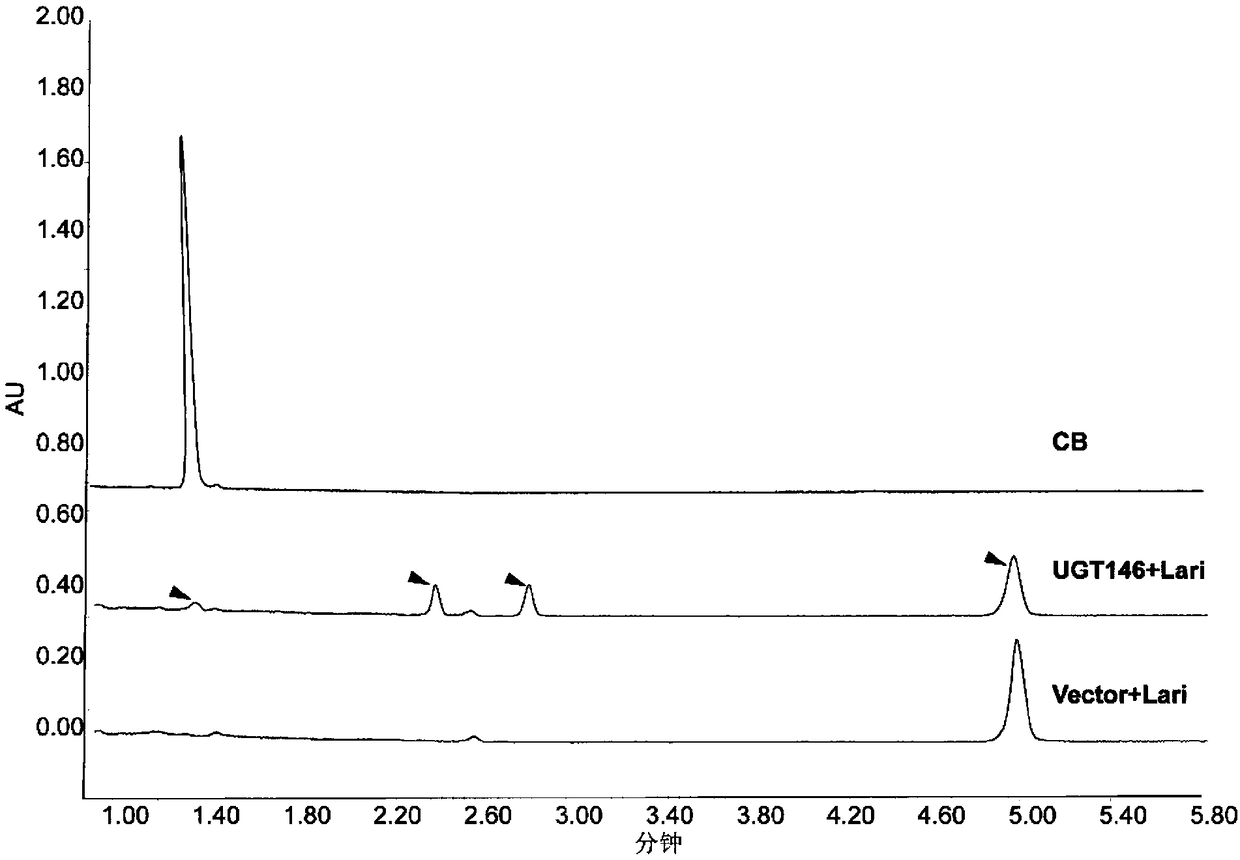Protein UGT146 as well as coding genes and application thereof
A technology of UGT146 and protein, applied in application, genetic engineering, plant gene improvement, etc., can solve the problems of unidentified coding genes, limited application, low content, etc.
- Summary
- Abstract
- Description
- Claims
- Application Information
AI Technical Summary
Problems solved by technology
Method used
Image
Examples
Embodiment 1
[0091] Embodiment 1, the preparation of recombinant glycosyltransferase
[0092] One, the acquisition of the coding gene (UGT146 gene) of the glycosyltransferase derived from Isatis indigo
[0093] The inventors of the present invention discovered the coding gene (UGT146 gene) of glycosyltransferase in Isatis sativa through a large number of experiments. The nucleotide sequence of the UGT146 gene is shown as sequence 1 in the sequence listing. The UGT146 gene encodes the protein UGT146, and the amino acid sequence of the protein UGT146 is shown in Sequence 2 in the sequence listing.
[0094] The amino acid sequence of protein UGT146 was searched for homology in Non-redundantGenBank CDS translation+PDB+Swissprot database using BLAST program in NCBI database.
[0095] UGT phylogenetic tree (neighbor-joining method) see figure 1 . The results showed that the protein UGT146 had high homology with UGT in other species at the amino acid level, and had a typical active site domai...
Embodiment 2
[0116] Example 2. Recombinant glycosyltransferase converts larch resinol to generate larch resinol monoglucoside and larch resinol diglucoside
[0117] The solution to be tested was the crude enzyme solution of recombinant bacteria A (induced by IPTG) or the crude enzyme solution of recombinant bacteria B prepared in Example 1.
[0118] 1. Prepare the reaction system. The reaction system consisted of 300 μL of the solution to be tested, 1.5 μL of larch resin alcohol solution (solvent in methanol, concentration 40 mM) and 3 μL uridine diphosphate-β-O-D-glucose solution (solvent in ultrapure water, concentration 40 mM).
[0119] 2. Take the reaction system prepared in step 1 and put it in a water bath at 30°C for 12 hours.
[0120] 3. Take the system that has completed step 2, add 2 times the volume of pure methanol (for the purpose of terminating the reaction), and shake to extract.
[0121] 4. After completing step 3, centrifuge at 13000rpm for 15min and collect the supernat...
Embodiment 3
[0136] Embodiment 3, the acquisition and identification of transgenic UGT146 hairy roots
[0137] 1. Construction of recombinant plasmid pCAMBIA1300-super-UGT146
[0138] The schematic diagram of the construction of the recombinant plasmid pCAMBIA1300-super-UGT146 is shown in Figure 5 .
[0139] 1. Using the PCR amplification product obtained in step 2 of Example 1 as a template, use primer 2F: 5'-GCTTCTGCAGGGGCCCGGGGATGAAACAGGAGCTGGTTTTC and primer 2R: 5'-GGATCCACTAGTTTTAAATgAGAGATATTCGAAGTGACATC to perform PCR amplification to obtain a PCR amplification product.
[0140] 2. Take the PCR amplification product obtained in step 1, perform agarose gel electrophoresis, and then use a DNA gel recovery kit to recover a DNA fragment of about 1500 bp.
[0141] 3. Take the pCAMBIA1300-super plant expression vector, cut it with the restriction endonuclease SalI, and recover the vector skeleton of about 10kb.
[0142] 4. Ligate the DNA fragment obtained in step 2 and the vector back...
PUM
 Login to View More
Login to View More Abstract
Description
Claims
Application Information
 Login to View More
Login to View More - R&D
- Intellectual Property
- Life Sciences
- Materials
- Tech Scout
- Unparalleled Data Quality
- Higher Quality Content
- 60% Fewer Hallucinations
Browse by: Latest US Patents, China's latest patents, Technical Efficacy Thesaurus, Application Domain, Technology Topic, Popular Technical Reports.
© 2025 PatSnap. All rights reserved.Legal|Privacy policy|Modern Slavery Act Transparency Statement|Sitemap|About US| Contact US: help@patsnap.com



